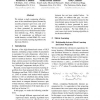107 search results - page 6 / 22 » Dimensionality reduction by unsupervised regression |
ACL
2010
13 years 5 months ago
2010
We initiate a study comparing effectiveness of the transformed spaces learned by recently proposed supervised, and semisupervised metric learning algorithms to those generated by ...
PAMI
2011
13 years 2 months ago
2011
—In solving complex visual learning tasks, adopting multiple descriptors to more precisely characterize the data has been a feasible way for improving performance. The resulting ...
NIPS
2008
13 years 9 months ago
2008
Probabilistic topic models have become popular as methods for dimensionality reduction in collections of text documents or images. These models are usually treated as generative m...
JMM2
2008
13 years 7 months ago
2008
Unsupervised or Self-Organized learning algorithms have become very popular for discovery of significant patterns or features in the input data. The three prominent algorithms name...
ICML
2004
IEEE
14 years 8 months ago
2004
IEEE
Principal component analysis (PCA) is a widely used statistical technique for unsupervised dimension reduction. K-means clustering is a commonly used data clustering for unsupervi...

